by Todd Rutherford
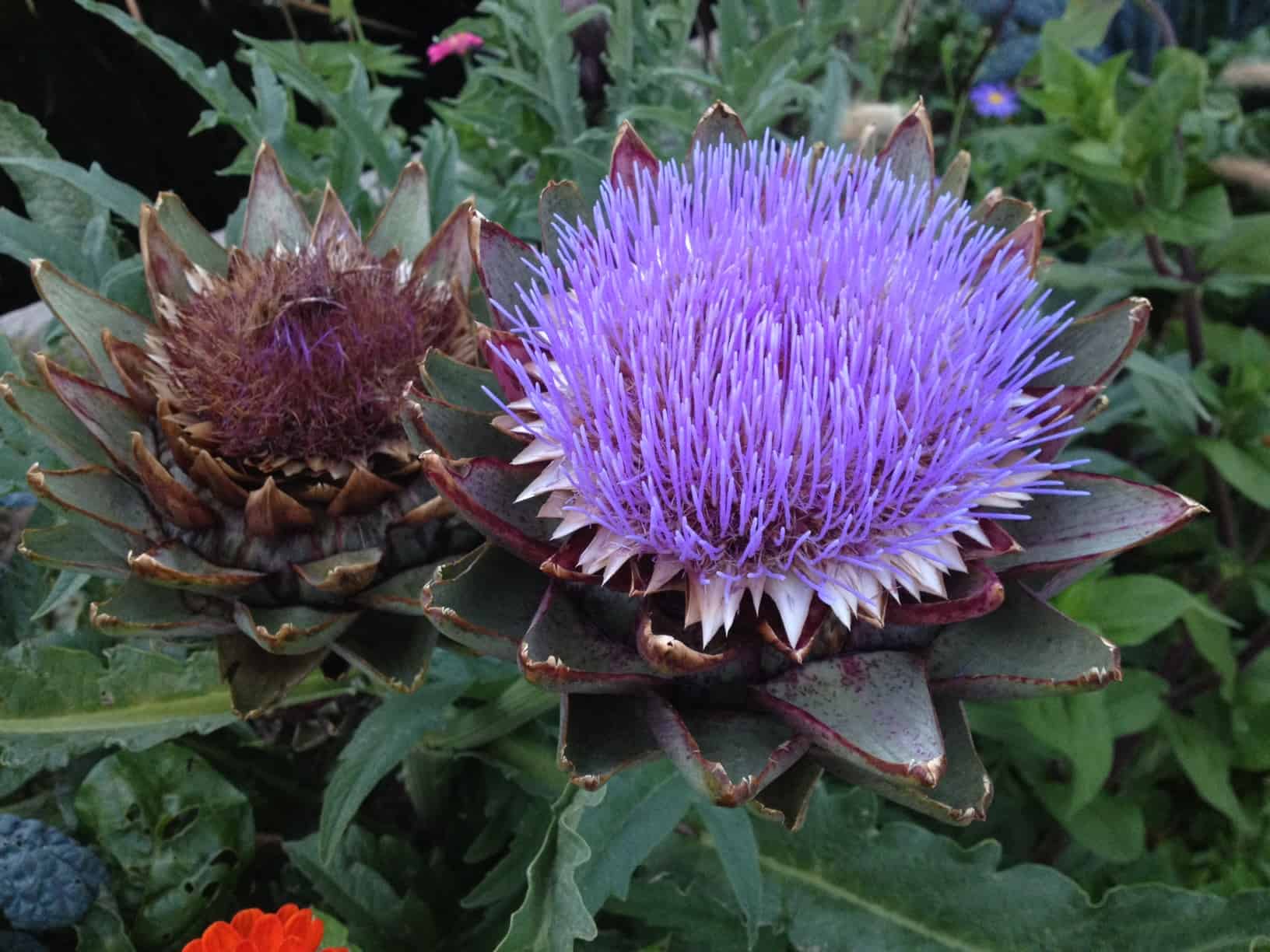
Many of the annual and vegetable plants at the Denver Botanic Gardens are at their peak right now, and looking amazing. This photo of an artichoke plant in bloom was captured in the garden’s Potager Garden area. Artichokes are typically known as a food crop, with several cultivars grown worldwide, but many horticulturalists like to grow it as an interesting ornamental plant. Their large leaves and spiky flowers add a wonderful sculptural form to the garden. It is my understanding that on a typical artichoke farm, the flower buds are harvested and sent to market well before they open. In these photos we see that the flowers have been allowed to open, providing a stunning display for garden visitors.
Artichokes look a lot like thistles. And it turns out, artichokes are indeed related to thistles, with both plants being members of the very large family of plants that botanists call the Asteraceae.
The historical record holds that artichoke cultivation as a food goes back as far as ancient Greek and Roman times. It is likely that the Greeks brought artichoke cultivation to Italy. Some historians posit that cultivation of artichokes was further developed and improved upon in medieval Muslim Spain. The name artichoke can be traced to the medieval Arabic term “ardi shawki“.
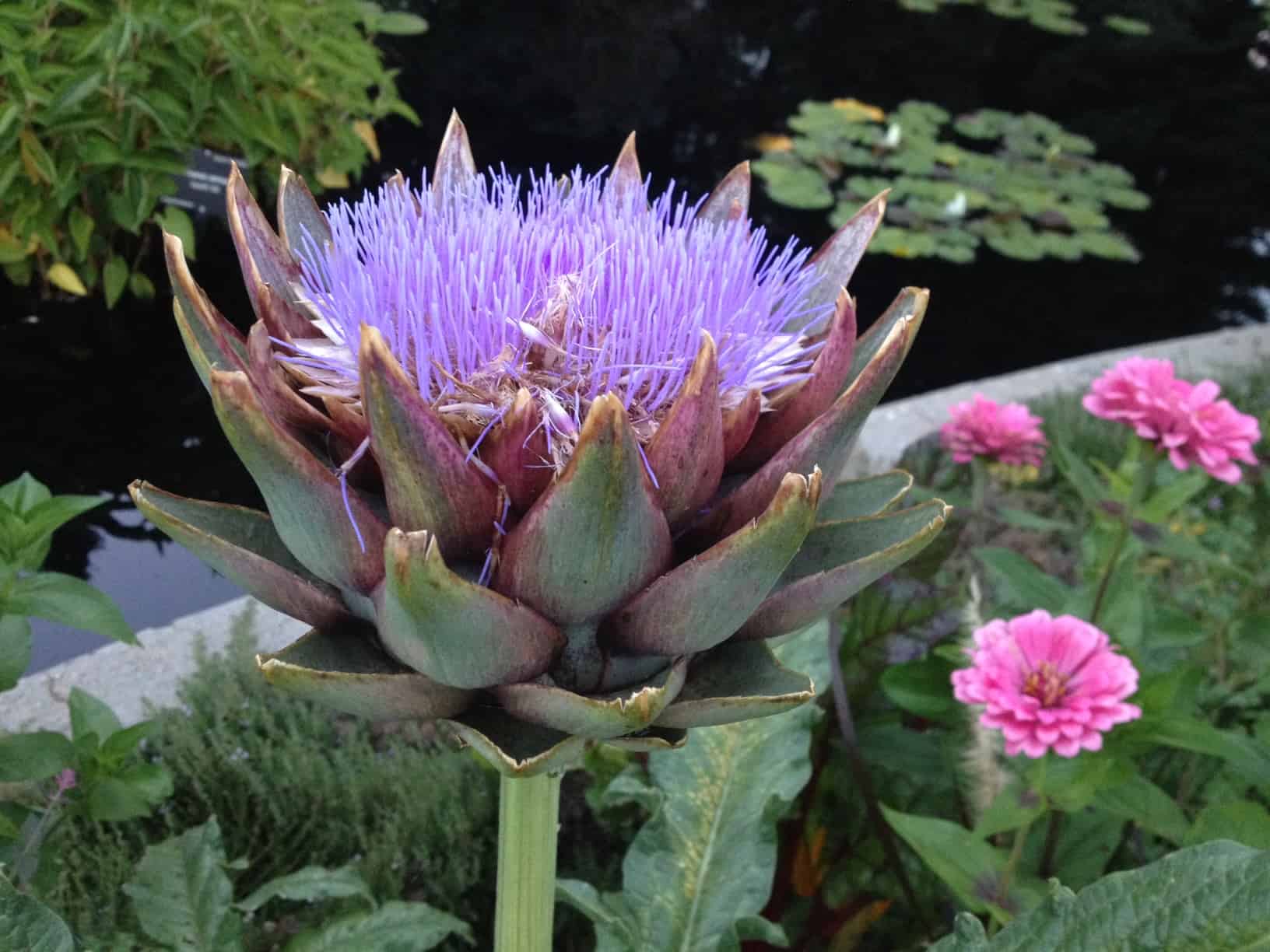
This is the official blog of Outdoor Design Group, Colorado Landscape Architects. For more information about our business and our services, click here.
Related Posts:
by Todd Rutherford
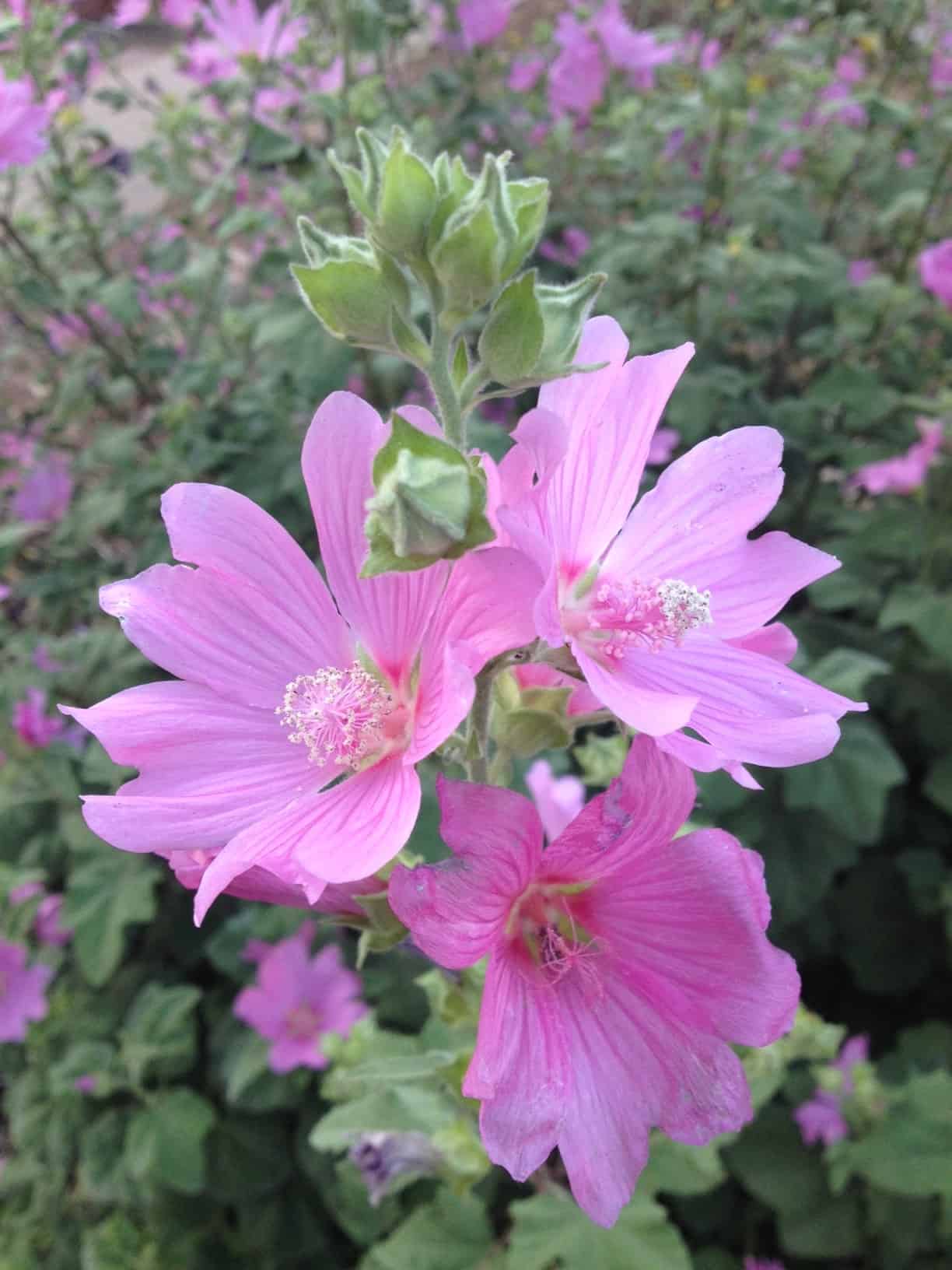
I had never heard of a Hollyhock Mallow, but I came upon this delightful plant while visiting a friend last month. This interesting horticultural specimen was blooming in my friend’s neighbor’s yard. The profusion of pink blooms caught my attention from the corner of my eye, and I instantly raced over to get a closer look. Initially the flowers brought to mind common hollyhocks, but the form of this plant and the leaves were not quite the same as true hollyhocks. It took a little bit of internet sleuthing to arrive at the conclusion of what the plant was. I am still trying to learn more about this plant to determine if it is a good addition to the list of perennial plants for low water gardens.
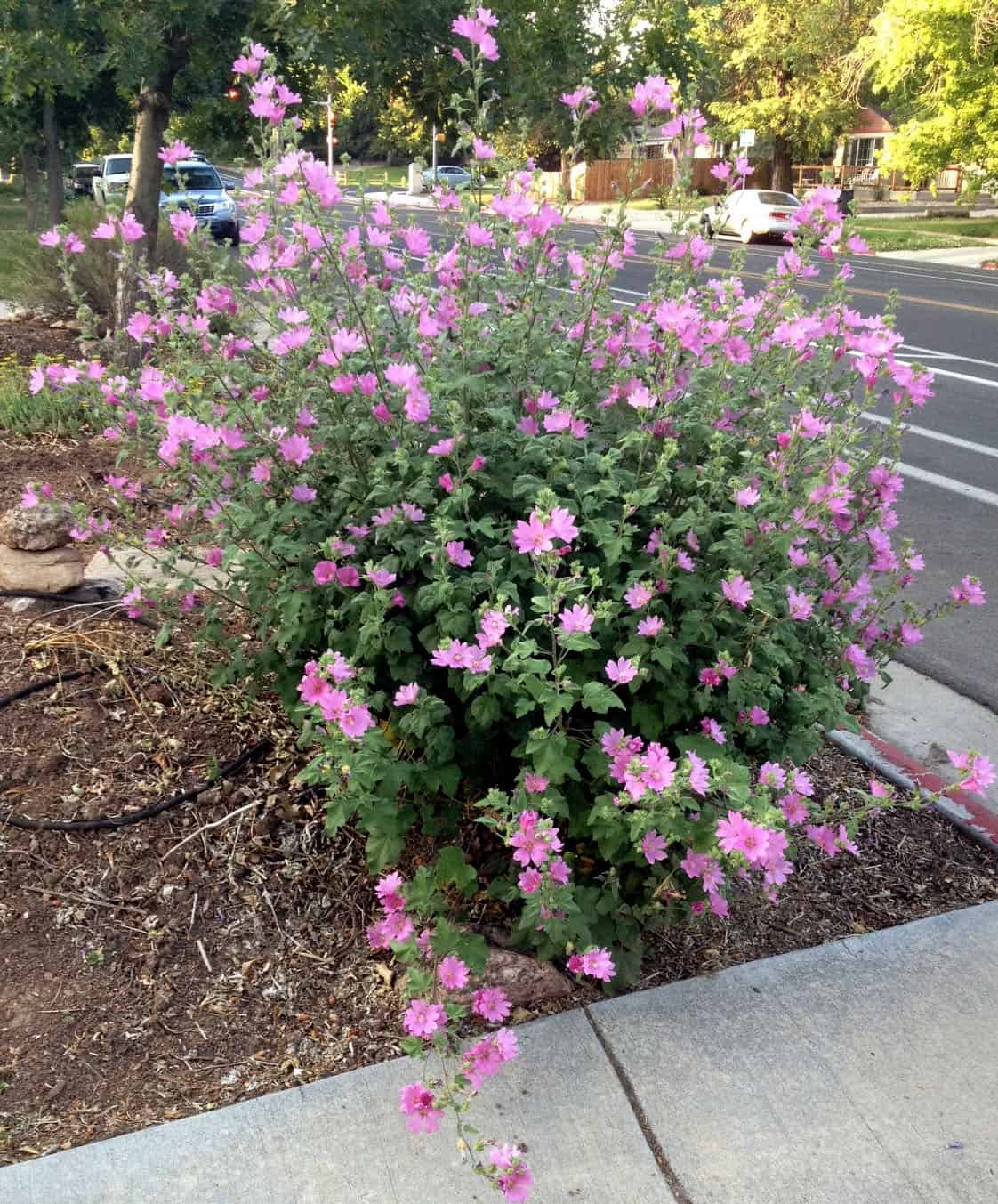
Hollyhock Mallow, aka Malva alcea, is native to parts of Europe and Central Asia. As the common name implies, it is related to common hollyhocks (Alcea rosea) that many a grandmother has grown from seeds. Malva alcea is an herbaceous perennial that grows about 4′ in height, by 2-3′ wide. It has moderate water needs, but reportedly is drought tolerant. Unfortunately, it can fall prey to Japanese beetles, foliar nematodes, leafhoppers and spider mites. I wonder if it is plagued by the same leaf problems that make common hollyhocks look so beleaguered towards the end of the growing season. In some regions of the U.S. it has escaped cultivation and become naturalized. I do not know if it is invasive in Colorado. I look forward to learning more about this plant, and possibly testing it out in my own garden beds.
This is the official blog of Outdoor Design Group, Colorado Landscape Architects. For more information about our business and our services, click here.
Related Posts:
by Todd Rutherford
Whether you’re an experienced or an inexperienced gardener, you’re probably aware of fall planted flowering bulbs. Tulips, daffodils, crocus, alliums, hyacinth and other “fall planted/spring blooming bulbs” have become very iconic harbingers of the advent of spring season. However, there’s a large assortment of flowering bulbs that make a spring-time appearance in garden retail stores, providing their own form of welcoming the passing of winter and the arrival of a new gardening season. The so-called spring planted flower bulbs may be lesser known to the novice gardener, but can be almost as valuable as the fall planted bulbs. These summer blooming plants can be used to place spots of color in-between perennials and shrubs in your landscape. Planted in Spring, these bulbs emerge to provide beautiful flowers throughout summer and fall, with exact flowering times varying per species and cultivar.
In fact, the spring planted bulbs are not all true bulbs. Some may be corms, rhizomes or tubers, which are all different types of storage organs that plants have evolved over time. It is these clever little storage devices that have allowed people to dig them up during plant dormancy, and package them up to be shipped to garden center stores around the world. Some of the spring planted bulbs are perennials, but most are not, at least in the USDA hardiness zone that Denver finds itself in.
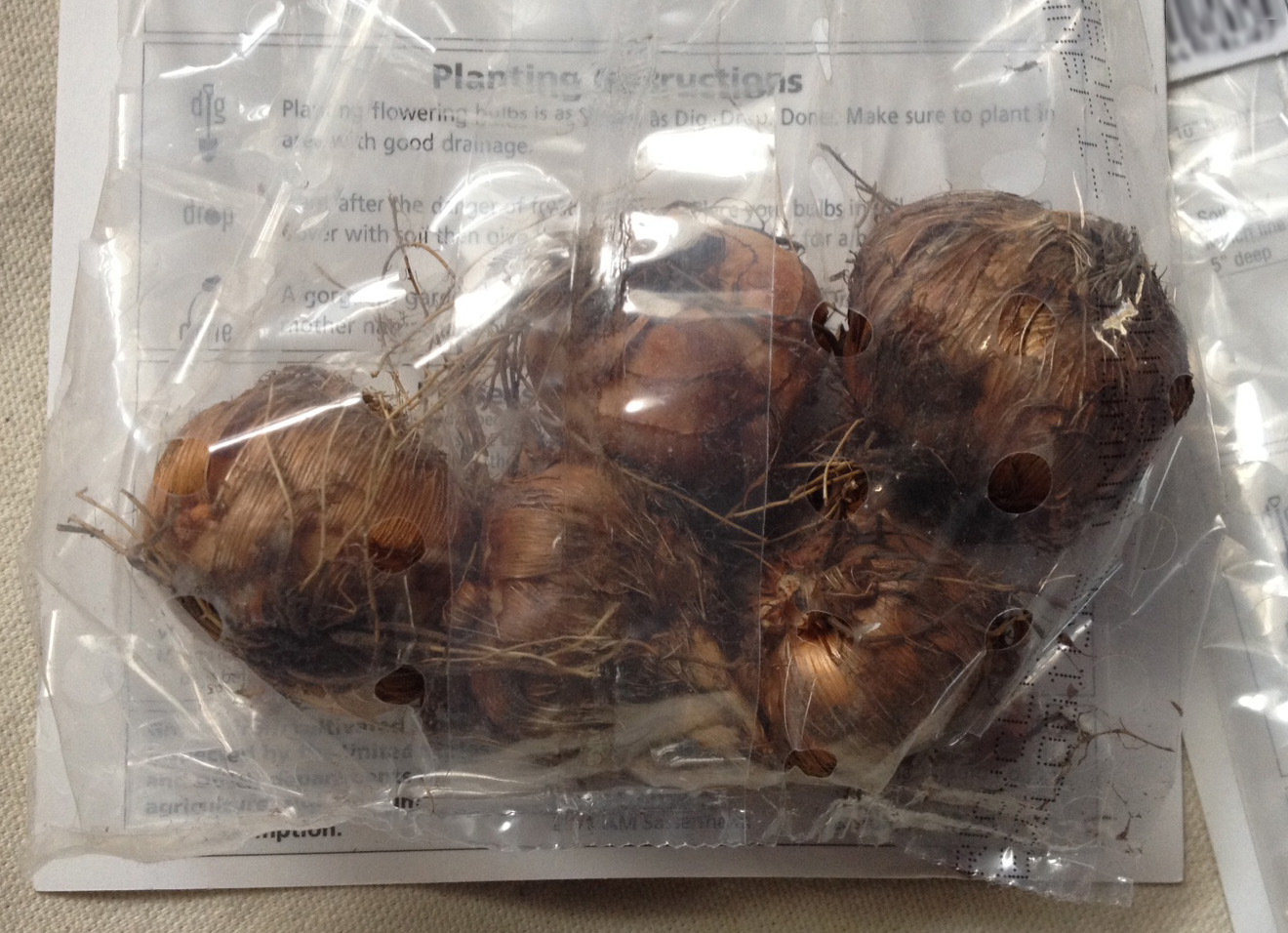
Crocosmia corms.
Out of the many types of spring planted ornamental bulbous plants available in your local garden center, I cover three common types here in this post.
Perhaps the best known spring planted bulb is the gladiolus, which hails from South Africa. Botanists consider the gladioli to actually be corms, not true bulbs. Corms are underground plant stems that function as storage organs, whereas true bulbs are underground storage organs made up of layers of fleshy modified leaves. Most gladioli are hardy only to zone 8, which makes them annuals in Colorado. But there are some gladioli that are hardy to zone 5, if well mulched in winter. Gladioli come in many colors and sport bright blooms on upright stems with strap-like leaves.
Like the “glads”, dahlias are another very popular summer bloom that is not hardy in Colorado. Dahlias are placed in the spring planted bulb category because they form tuberous roots which are dried and then sold. The pre-cultivar dahlias are native to Mexico. There tubers were used as a food crop by the Aztecs. The trick to buying dahlias in dry form is that they must have a stem attached to the tubers, because only the stems produce buds, which then produce stems and flowers. There is a huge variety of dahlia cultivars to be found in garden centers. In springtime, the dahlia tubers are sold in bags along with the other spring planted bulbs. But in summer it is common to see the dahlias sold as potted plants. Buying them as tubers is cheaper than as potted plants. Because the dahlias are hardy only to zone 8, if you want them to return to your yard next summer you must save the tubers (with a bit of the stems attached) in a cool but not freezing space, to be replanted in a successive season. Or simply just buy new ones each spring. Dahlias are popular because the blooms come in a multitude of shapes, colors and sizes. If you’ve never seen a 12 inch wide “dinner plate” dahlia flower in bloom, you are missing out on a fascinating sight.
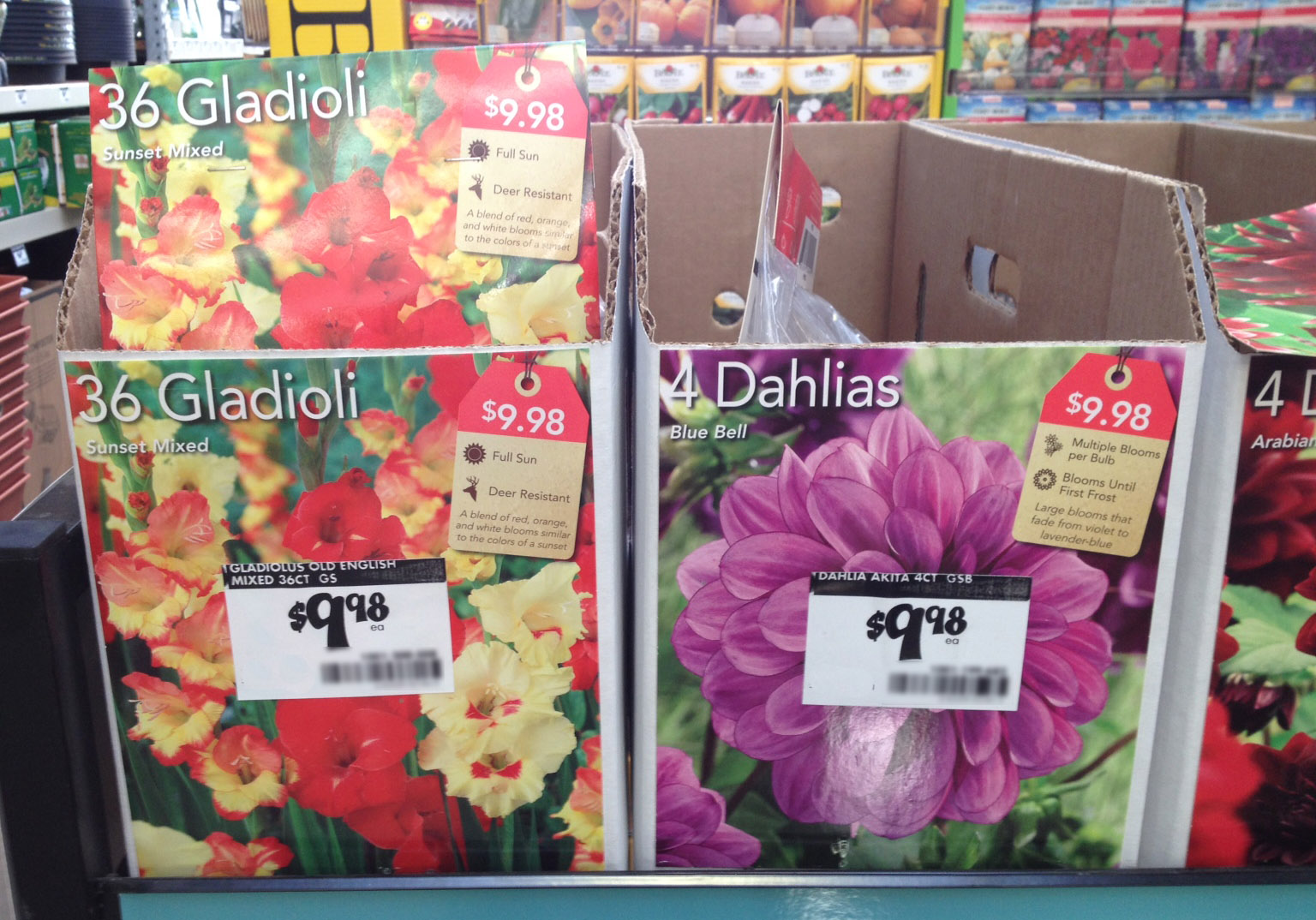
Canna Lilies are another spring planted “bulb” that bring an air of the tropics to your landscape. These flowering plants are often used in annual pots, providing tall, colorful focal points in the center surrounded by lower annuals. Cannas are native to Latin America and are grown as annuals in Denver’s hardiness zone of 5. But if you find the right micro-climate, they may over-winter just fine. I know of one house in Denver, where cannas are planted at the base of a south facing wall on a house, and have become perennial in this residential landscape due to this warm micro-climate spot. Cannas are not true bulbs, but are “rhizomatous.” A rhizome is an underground horizontal stem that can send out shoots and roots from nodes. A ginger “root” is an example of a rhizome that you’ll find in a produce section. Cannas are closely related to ginger and also bananas! Another familiar rhizomatous plant are irises, which have above ground rhizomes. Although canna lilies are often available as potted plants throughout summer, if you purchase them as rhizomes in spring, you get the plants for a fraction of the cost of potted ones. As mentioned previously, cannas develop tropical-like flowers and leaves, giving your patio an island vibe.
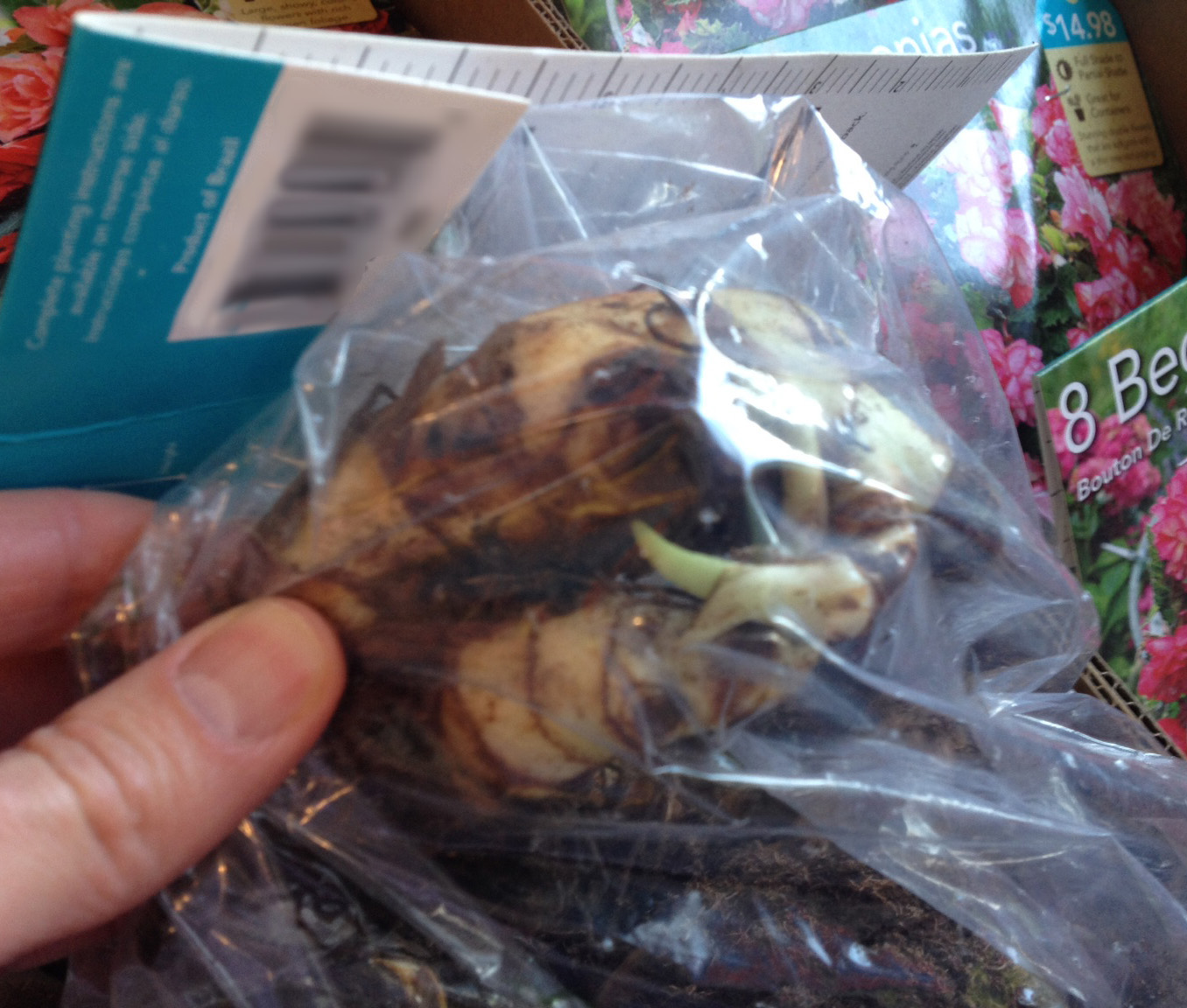
Canna rhizomes.
Head on down to your local garden center this spring gardening season and pick up some spring planted bulbs to brighten your landscape this summer!
This is the official blog of Outdoor Design Group, Colorado Landscape Architects. For more information about our business and our services, click here.
Related Posts:
by Todd Rutherford
When it comes to trees in designed landscapes in Colorado, landscape architects and designers don’t have very many species to choose from. With that being said, it might seem heretical to propose that the list of trees to pick from be restricted even further. Specifically, I advocate that large evergreen trees NOT be planted in dense urban areas that experience cold winters, unless they are sufficiently distant from walks and streets located north of such evergreens.
The shadows that large evergreen trees cast can help foster ice patches on walks and roads, compromising the safety and welfare of those who utilize these areas to travel about our towns and cities. If we are going to encourage biking and walking to ease automobile congestion and alleviate environmental impacts, having the safest travel routes we can achieve is a noble goal.
It may be surprising to those who don’t work in the landscape, architecture or planning fields, but many municipalities require that a certain number or percentage of the trees on a landscape plan be evergreen trees. Sometimes these arbitrary requirements restrict designers and architects to squeeze these large winter-shading ice patch-makers into a site where it might be best to avoid them. However, I should mention that some municipalities that I’ve worked with do acknowledge the problem of winter shading from evergreen trees, and they do have instructions in their landscape codes to locate proposed large evergreens away from walks and roads that would be shaded by those evergreens.
I first became aware of the problem of evergreen shadow ice patches as an urban bike commuter in the Denver area. It is frustrating at best, and rather dangerous at worst to encounter a patch of ice on a street during winter time. I have found that often times when biking in the Denver area in winter, the majority of streets can be clear of ice, except for those areas shaded by evergreens that are located just south of walks and streets. But it is not just bikers that would benefit from restricting evergreen trees in urban areas. Walkers and runners would also have an improved level of travel safety due to less icing of their pathways.
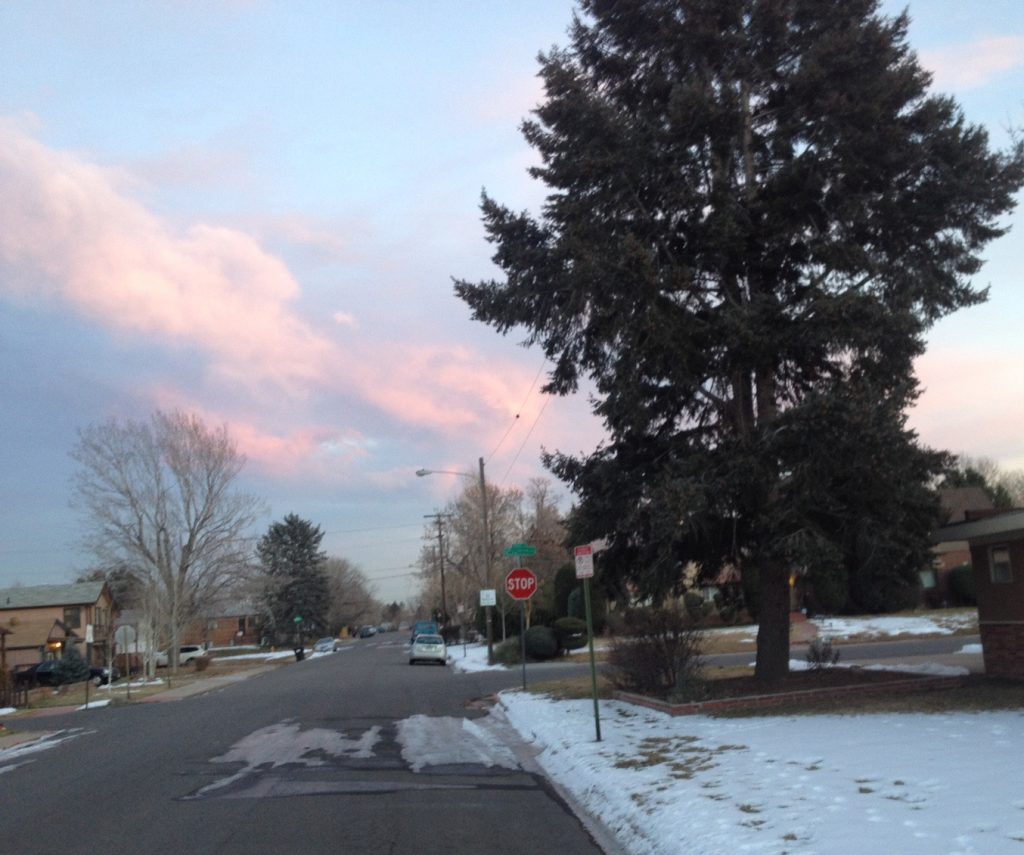
An ice patch on a Denver street, from the shadow of a large evergreen tree.
Because the foliage canopy of pine, spruce and fir trees does not drop during winter, melting of snow and ice via solar gain is limited. Deciduous trees, which drop their leaves and allow more sunlight to reach walks and streets, are a better choice in place of evergreens. I acknowledge that evergreen trees are often used for landscape screening. But I question whether this screening is worth it when considering their impact to roads and walks during winter.
Another impact from lost solar gain due to evergreen tree shading is on homes and other buildings. A building that sits in the winter shadow of a large evergreen tree will miss out on solar warmth during a sunny Colorado winter day.
I do realize that in dense urban areas, it’s not just trees that can shade our streets and sidewalks. People need shelter and workspaces, and some of those structures could end up shading streets and cause ice patches. But residents don’t need evergreen trees on their urban lot. I advocate for trees to create shade in summer, visual interest in all seasons, and wildlife habitat. But the choice of tree in tight urban quarters needs to be considered carefully.
Despite the tongue in cheek title of this blog post, evergreen trees can be a wonderful addition to the landscape. I am not actually asking for evergreen trees to be banned from urban areas of Colorado. However it does seem best that in dense urban areas that experience cold winter weather, we should consider restricting evergreen trees to parks and large lots, away from streets and sidewalks where their winter shade will not cause icy travel dangers for walkers, bikers and even cars.
This is the official blog of Outdoor Design Group, Colorado Landscape Architects. For more information about our business and our services, click here.
Related Posts:
by Todd Rutherford
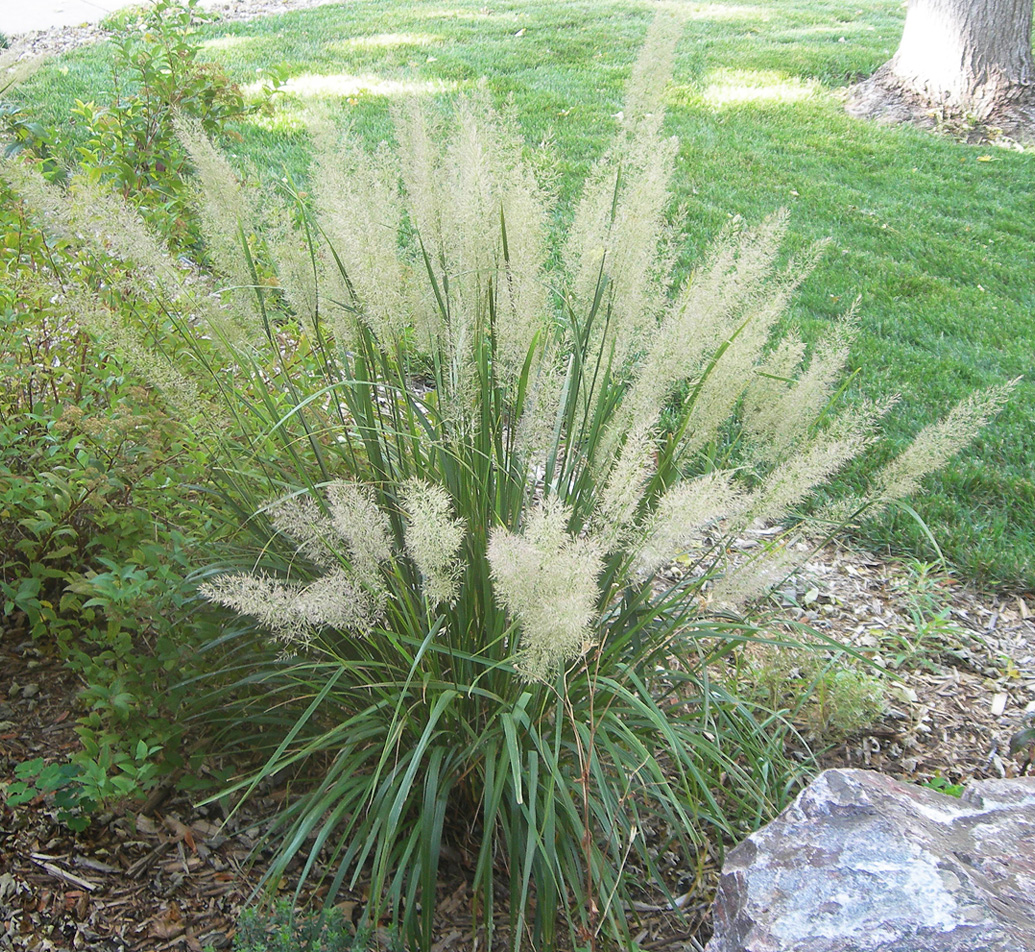
Calamagrostis brachytricha, Korean Feather Reed Grass
Calamagrostis brachytricha, aka Korean Feather Reed Grass, is a clump-forming ornamental grass with green leaves and fluffy flower plumes. It is not as well known as its infamous cousin Calmagrostis acutiflora ‘Karl Foerster’, commonly known as Karl Foerster Feather Reed Grass. But Korean Feather Reed Grass really should get more attention, as it is an indispensable option to add wispy texture to planting schemes in part shade conditions.
PLANT STATS
Scientific Name: Calamagrostis brachytricha
Common Name: Korean Feather Reed Grass
Plant Type: Ornamental Grass
Mature Height: 3-4’
Mature Spread: 2-3’
Cold Hardiness Zone: USDA zones 4 – 9 (up to 6,500 ft)
Water Requirement: Medium. Slightly drought tolerant once established, but prefers adequate moisture. Requires regular amounts of water if it is planted in more sun.
Exposure: Part Sun/Shade
Soil: Tolerant of a wide range of soils.
Flower Color & Bloom Time: The feather like flower spikes have a pink tinge when they initially emerge in late summer, and then fade to straw yellow in fall. Compared to Karl Foerster grass, the flowers of Korean Feather seem to be much more misty and gauzy when they first appear which gives the plants a wonderfully diaphanous appearance.
Winter Interest: Gold foliage and flowers.
Disadvantages: May reseed under certain conditions.
Availability and Sizes: This plant seems to be regularly available at retail nurseries around the front range. It is typically sold in 1 gallon or 4″ pots.
Best Features: A large, showy, flowering ornamental grass that can take shady conditions.
Maintenance Tip: Like other ornamental grasses, trim plants down to about 4-6” above the surrounding soil in late winter or early spring, before new growth begins to emerge.
This is the official blog of Outdoor Design Group, Colorado Landscape Architects. For more information about our business and our services, click here.
Related Posts:








